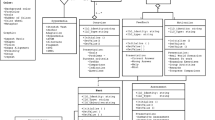Abstract
We have recently begun a major project to design, develop, and implement an enriched learning environment (ELE) for undergraduate education. Our initial thinking was very technology oriented. A hypermedia environment would allow students to explore a knowledge domain and see the relations between ideas; it would allow students and instructors to create new links and new units of information reflecting their interests and needs; it would permit faculty to catalogue and organize their instructional materials and permit them to create high quality text, graphics, and even animation in the comfort of their office; and finally, it would permit students and faculty to communicate and debate. We were attempting to define a technology that would be all things for all students and instructors. It would be a tool that would serve any use of a database and any communication in the learning process. Those rather naive notions have long since passed.
Access this chapter
Tax calculation will be finalised at checkout
Purchases are for personal use only
Preview
Unable to display preview. Download preview PDF.
Similar content being viewed by others
References
Conklin, J. (1987). Hypertext: A survey and introduction. IEEE Computer, 20 (9). (pp. 17–41).
Hammond, N. (1989). Hypermedia and learning: who guides whom? ICCAL Proceedings’ 89, (pp. 167-181).
Yankelovich, N., Landow, G. & Cody, D. (1987). Creating hypermedia material for English students. Sigcue — Outlook, 20, (pp. 1–11).
Bush, V. (1945). As we may think. The Atlantic Monthly, 176 (1), (pp. 101–108).
Nelson, T. H., (1981). Literary Machines. Swathmore, PA: Nelson.
Yankelovich, N. & Meyrowitz, N. (1985). Reading and writing the electronic book. Computer, (10), 15–30.
Palmer, J., Duffy T., and Mehlenbacher, B. (In press). A System for Aiding Designers of Online Help. Lotus:acm SIGCHI.
Beeman, W., Anderson, K., Bader, G., Larkin, J., McClard, A., McQuillan, P., and Shields, M. (1987). Hypertext and pluralism: From lineal to nonlineal thinking. Hypertext’87 Papers, (pp. 1-20).
Beeman, W., Anderson, K., Bader, G., Larkin, J., McClard, A., McQuillan, P., and Shields, M. (1988). Intermedia: A case study of innovation in higher education. (A final report to the Annenberg/CPB project). Providence, RI: Brown University, IRIS.
Yankelovich, N., Landow, G., and Heywood, P. (1987). Designing hypermedia Ideabases-The Intermedia Experience. (IRIS Technical Report 87-4). Providence, RI: Brown University, IRIS.
Brown, J. S., Collins, A., &Duguid, P. (1989). Situated cognition and the culture of learning. Educational Researcher 18 (1), 32–42.
Jones, B. F., Pierce, J., &Hunter, B. (1988). Teaching students to construct graphic representations. Educational Leadership, (pp. 20-25).
McQuillan, P. (1987). Computers and pedagogy: The invisible presence. Technical Report, Brown University, IRIS, Providence, RI.
Franklin, C. (1988). The hypermedia library. Database, 11 (3), (pp. 43–48).
Crane, G., & Mylonas, E. (1988). The Perseus project: An interactive curriculum on classical Greek civilization. Educational Technology 28 (11), (pp. 25–32).
Collins, A., Brown, J. S., & Newman, S. E. (1988). Cognitive apprenticeship: Teaching the craft of reading, writing, and mathematics. In L B. Resnick (Ed.), Cognition and instruction: Issues and agendas. Hillsdale, NJ: Erlbaum.
Akscyn, R. M., McCracken, D.L., and Yoder, E.A. (1988). KMS: A distributed hypermedia system for managing knowledge in organizations. Communications of the ACM, 31, (pp. 820–835).
Walker, J., H., (1989). Authoring tools for complex document sets. In E. Barrett (Ed.), The society of text. MIT Press.
Egan, D. E., Remde, J. R., Landauer, T. K., Lochbaum, C. C., & Gomez, L. M. (1989). Behavioral Evaluation and analysis of a hypertext browser. CHI’89 Proceedings, (pp. 205-210).
Wittgenstein, L. (1953) Philosophical investigations. New York, NY: Macmillan.
Shoemaker, H. (1967). The functional context method of instruction. HumRRO Professional Paper No. 35-67, Alexandria, VA: Human Resources Research Organization.
Sticht, T. G. (1975). Reading for working: Afunctional literacy anthology. Alexandria VA: Human Resources Research Organization.
Bransford, J. D., Sherwood, R.D., Hasselbring, T. S., Kinzer, C. K., and Williams, S. M. (in press). Anchored instruction: Why we need it and how technology can help. To appear in a volume edited by D. Nix & R. Spiro. Hillsdale, NJ: Erlbaum.
Simon, H. A. (1980). Problem solving and education. In D. T. Tuma & R. Reif (Eds.), Problem solving and education: Issues in teaching and research. Hillsdale, NJ: Erlbaum.
Spiro, R. J., Poulson, R. L., Feltovich, P. J., & Anderson, D. K. (1988). Cognitive flexibility theory: Advanced knowledge acquisition in ill-structured domains. In Proceedings of the Tenth Annual Conference of the Cognitive Science Society, 375–383. Hillsdale, NJ: Lawrence Erlbaum.
Sticht, T. G. and Hickey, D. T. (1988). Functional context theory, literacy, and electronics training. In R. Dillon & J. Pellegrino (Eds.), Instruction: Theoretical and Applied Perspectives. NY: Praeger Publishers.
Palincsar, A. S., and Brown, A. L. (1984). Reciprocal teaching of comprehension fostering and comprehension monitoring activities. Cognition and Instruction, 1 (2), (pp. 117–175).
Schoenfeld, A. H. (1985). Mathematical problem solving. New York: Academic Press.
Scardamalia, M., and Bereiter, C. (1985). Fostering the development of self-regulation in children’s knowledge processing. In S. F. Chipman, J. W. Segal, & R. Glaser (Eds.), Thinking and learning skills: Research and open questions. Hillsdale, NJ: Erlbaum.
Author information
Authors and Affiliations
Editor information
Editors and Affiliations
Rights and permissions
Copyright information
© 1990 Springer-Verlag Berlin Heidelberg
About this chapter
Cite this chapter
Duffy, T.M., Knuth, R.A. (1990). Hypermedia and Instruction: Where is the Match?. In: Jonassen, D.H., Mandl, H. (eds) Designing Hypermedia for Learning. NATO ASI Series, vol 67. Springer, Berlin, Heidelberg. https://doi.org/10.1007/978-3-642-75945-1_12
Download citation
DOI: https://doi.org/10.1007/978-3-642-75945-1_12
Publisher Name: Springer, Berlin, Heidelberg
Print ISBN: 978-3-642-75947-5
Online ISBN: 978-3-642-75945-1
eBook Packages: Springer Book Archive




